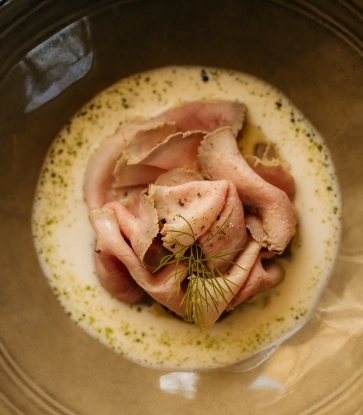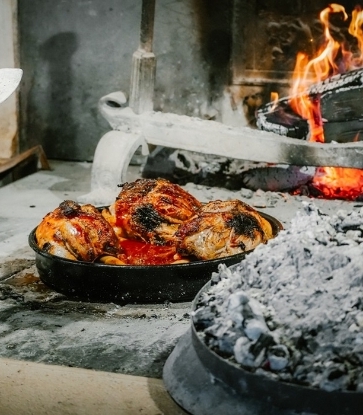In addition to restaurants that are visible along almost every street in the city, the cuisine on offer in Buenos Aires also includes eateries that are concealed from view but which offer an intimate setting and culinary surprises galore.
A Fuego Fuerte: a restaurant full of surprises!
A Fuego Fuerte, which is recommended in the MICHELIN Guide, looks like a family home from the outside but is in fact a fine-dining restaurant run by owner-chef Julio Lunghi Mazzieri in a residential district of Buenos Aires. It is fronted by a large wooden door, although you won’t find a restaurant sign to show it’s there at all, just a bell. “The fact that we operate behind closed doors is an indication of the discreet service that we can offer our guests”, Julio explains. Once inside, however, there is a complete transformation, both in terms of space and depth, including a large dining room for just 16 guests, with tables covered with white tablecloths, along with individual armchairs, floral displays in the middle of each table, crystal glassware, designer crockery and an array of luxurious details.The 17-course menu features scrupulously selected ingredients: Uruguayan caviar, spider crab from Ushuaia, trout from Patagonia and a bonbon of duck pâté, the meat for which is sourced from a breeder in Francisco Madero, the town in Buenos Aires province where the chef was born. The meticulously prepared, unexpected and most popular dishes on the menu include rump of Wagyu, served with quinoa and cooked in different ways; the deconstructed risotto; and magret de canard, among others. “The last part of the menu has its own individual character, on which we like to surprise guests the most: Bonbons of rocoto peppers and rosemary or Remolacha ice-cream and avocado ganache are just two examples”, Julio adds. This creative and highly personalised gastronomic journey of discovery is far removed from the traditional restaurant concept.
Casa Cavia: a mansion, a terrace and a fountain
Located opposite a tree-lined park, in a street with a tranquil and leisurely ambience, stands this old two-storey property with an immaculate white façade. This space, originally designed in 1927 by the architect Alejandro Christophersen, is now home to Casa Cavia, one of the city’s most beautiful dining spots, where you’ll find a restaurant, café, bar, bookshop, florist’s and publisher that add light, splendour and flavour to the nooks and crannies of this old mansion. “Nowadays, everyone is familiar with this house, and it has been photographed by thousands of people over the years. It is a marvel of architecture and as such we want to maintain its welcoming quality of a family home that is always open to the public so that visitors can enjoy this residence which has so much architectural value”, says Guadalupe García Mosqueda, Casa Cavia’s manager.
The cuisine created by Julieta Caruso (who has nine years’ experience working at Mugaritz in Spain behind him) is focused around a quest for local ingredients, many sourced from his own kitchen garden, and a meticulous and delicate approach to proteins. His menu here changes through the day: enjoy a Sunday brunch on the internal terrace to a backdrop of birdsong and the gentle burbling of water in the central fountain; a coffee accompanied by a homemade pastry; an innovative sunset cocktail from the bar run by Flavia Arroyo; or a relaxed dinner featuring dishes such as Lilacs, toasted scallops and white garlic and Fried fish with crispy fennel and bagna cauda.

Marti: discreetly located behind the premises of a clothes designer
When chef Germán Martitegui opened Tegui over 15 years ago, he hid this restaurant behind a wall covered with stencils and graffiti. Today, his new culinary adventure, called Marti, is similarly hidden from view. You’ll need to ring the bell, then walk through a long corridor to reach the spacious, bright dining room – a glass-enclosed space surrounded by plants and verdant vines. The change is abrupt: all of a sudden, an open kitchen appears in the middle of the restaurant, surrounded by a large rectangular counter. To one side, you’ll see the hongario (from hongo, meaning mushroom in Spanish), the glass-fronted cellar where the wild mushrooms that star in several of Marti’s dishes are grown.
Marti occupies what used to be the open-air patio of the renowned clothes designer Martín Churba. Here, the focus is on vegetarian cuisine, featuring small plates of street-style cooking and flavours with influences from around the world, all created under Martitegui’s watchful eye. The mushroom shawarma is already one of its signature dishes, as are the cheese soufflé and the zucchini and parmesan tortellini, not forgetting the beetroot tartare with quinoa and pupusa, and the lion’s mane mushrooms with mole and olluco. “From outside you can’t see anything, but once you’re inside everything comes into view. At Marti I wanted to create a setting that is more accessible to people, and to avoid the course-style menus that you find at Tegui. My restaurants are an expression of what I am thinking at every moment of the cooking process”, says the chef.

An open stage: 4ta Pared
It is said that the best hiding place for a tree is in a wood. And it is this statement that helps to define 4ta Pared, a restaurant with a glass-fronted presence on the street but which adopts a behind-closed-doors approach inside. A reservation is essential here, and once you arrive, you need to ring the bell before choosing one of the dining spaces available: either the small main dining room or the more intimate chef’s table, where you can watch chef Pablo Cerne create each dish in front of your eyes. “The Cuarta (4ta) Pared (Fourth Wall) is a term used in theatre and film to describe the imaginary invisible wall that divides actors from their audience. It is said that the fourth wall is broken down when the actor momentarily steps back from his or her role to interact directly with the audience. We interpret gastronomy in similar terms: our tasting menu is a work of art over several acts, with spectators and actors interacting with each in other in a shared space”, Pablo tells us.

The menu is divided into four parts (each with different options), and changes monthly in line with the kitchen team’s imagination and the influence of the seasons. The Wood-fired focaccia with koji butter and fish roe acts as an impressive appetiser followed, perhaps, by the Grilled fish with okra, lemon foam and mussels, the Grilled cauliflower with a quinze demi-glaze, kefir pesto and huacatay, and the mouth-watering mature cut of veal. The service is friendly, the pacing perfect, and the dishes absolutely delicious, ensuring an experience that blurs the boundaries between the chefs and their guests.
Buri Omakase: a corner of Japan
“When I travelled to Japan, I realised that it is commonplace to find restaurants in unconventional locations, such as in basements, inside large buildings, or in arcades or malls. I found the same thing in other parts of Asia. This is why I decided to set up Buri Omakase in a secretive off-street location, which really enables my guests to truly remove themselves from the world around them and to enjoy a more immersive experience”, Marcello El, the sushi chef and owner of this small MICHELIN-recommended omakase with just 10 seats, explains.

In total, the menu consists of 15 dishes divided into three “moments”: firstly, dishes such as Tartare of Wagyu beef, Carpaccio of langoustine, and Curried mussels, followed by sashimi of fish such as amberjack, mackerel or sole. It is then the turn of the nigiris, including red mullet or bluefish with grated fresh ginger. What differentiates Buri from other Japanese restaurants is Marcello’s passion for fresh fish from Argentina, which he only sources from trusted fishermen from the Mar del Plata and other ports along the Atlantic coast.
Restó SCA: a classic restaurant with a low profile
A restaurant with 27 years of history behind it, Restó SCA occupies a building dating back to the 1900s, the rear of which was once the entrance for horse-drawn carriages. During a period spanning almost three decades, this restaurant has had just three owner-chefs, each one of whom has brought with them their own way of working and cooking. First came María Barrutia, then Guido Tassi, and today it is the culinary fiefdom of María Magdalena Piaggio. “One of the major advantages of being in a place that is tucked away from the general public is that it is able to maintain its own unique intimacy, something that our guests greatly appreciate. As soon as you walk into this building, which now belongs to the Sociedad Central de Arquitectos, guests are taken on a journey back in time”, Piaggio tells us.

The menu here encompasses the flavours of the Mediterranean to the backdrop of a restrained French bistro-style decor, featuring starters such as Pulpeta di búfala with gremolata and figs, Sautéed squid with a spicy tomato chutney and papa rosa, and Lamb escabeche with quail egg. Mains include Rack of Patagonian lamb with yuca rosti and quince chutney, Green risotto with lamb confit, and Quail stuffed with spinach, ricotta and walnuts served with Granny Smith apple purée and Brussels sprouts, followed by desserts featuring 70% chocolate mousse with cardamom-infused crème anglaise, and Grilled pineapple with coconut ice-cream and a sablé biscuit. Every dish here is prepared according to classic techniques, with top-quality ingredients taking centre stage.

Fogón Asado: a reinterpretation of tradition
If there’s one thing Argentina has in abundance it’s steakhouses! And one of these is Fogón Asado, which sets itself apart both in terms of its decor and its parrilla cooking. “We made the decision not to have any external signage and to offer just one sitting in the evening to enable us to increase the sense of mystery and expectation for our guests. By doing so, we are able to create a strong contrast between the calm of the exterior and the dynamic nature of events inside, while always focusing on a personal approach to the country’s grilled meat traditions”, Fogón Asado’s owners Alex Pels and Danielle Jenster explain.

For dinner, we have space for 35 guests, who are divided between different dining spaces, each with their own menu. The Chef’s Counter offers seating for a small group of 10 guests overlooking the grill, where the focus is on a 9-course menu featuring a comprehensive selection of Argentina’s grilled meat dishes, alongside some of the restaurant’s own personal touches, such as the Provoleta with grilled fruit, the Chorizo with grilled red peppers, and the Sweetbreads with roasted tomatoes and ginger. One of the restaurant’s strong suits is the Asado, from the five middle ribs, which are slowly braised in red wine, then wrapped in foil with a salsa of red miso, mirin, rice vinegar and honey in order to caramelise and give a golden glaze to the meat. The Rib-eye cap, meanwhile, is aged for 30 days then smoked over pine cones. Lastly, the Crêpes with dulce de leche and red Patagonian berries are a perfect and delicious way to end your meal.

Hero image: © A Fuego Fuerte
This article has been written with the support of our Destination Partner in the "MICHELIN Guide Buenos Aires & Mendoza 2024".










